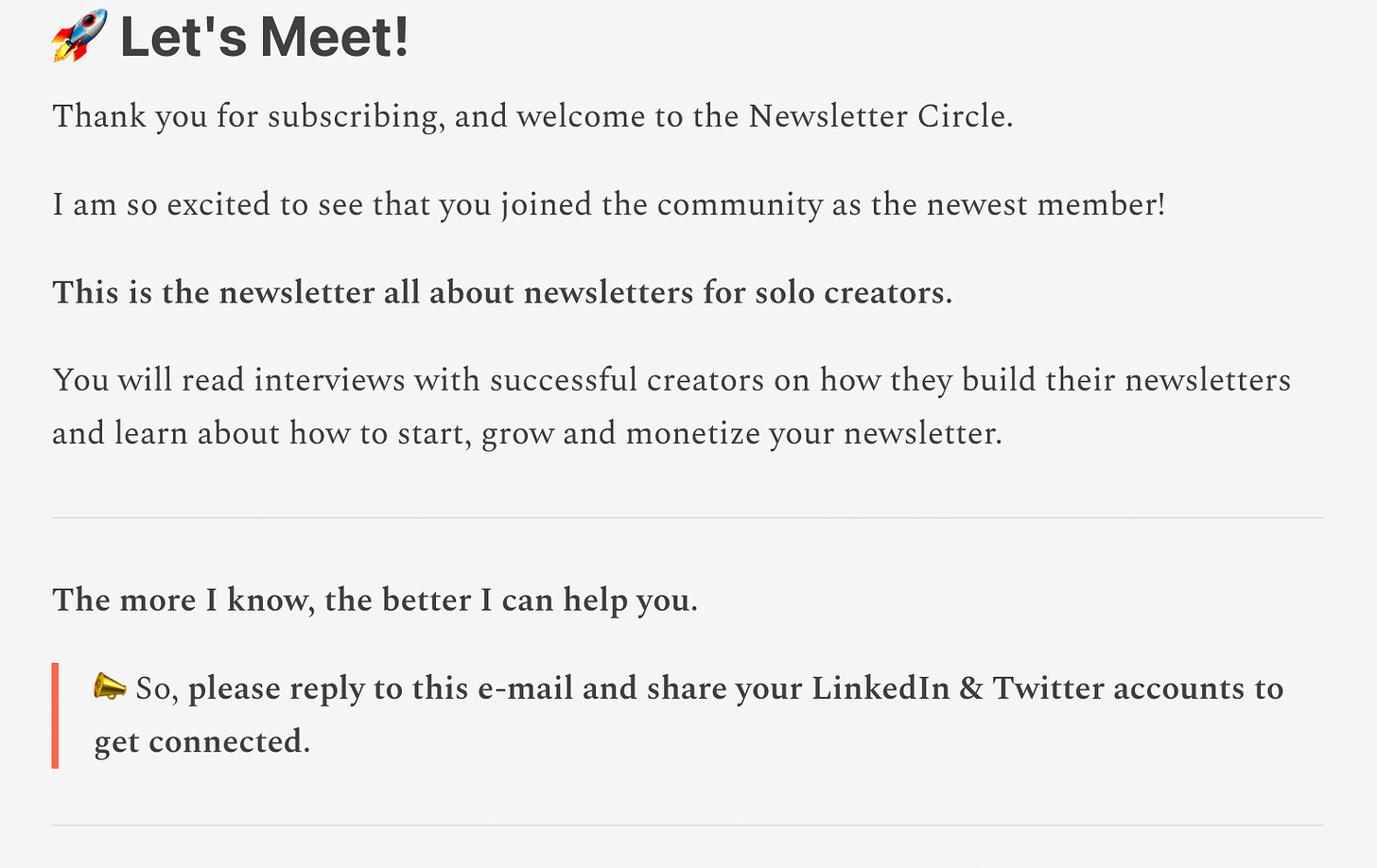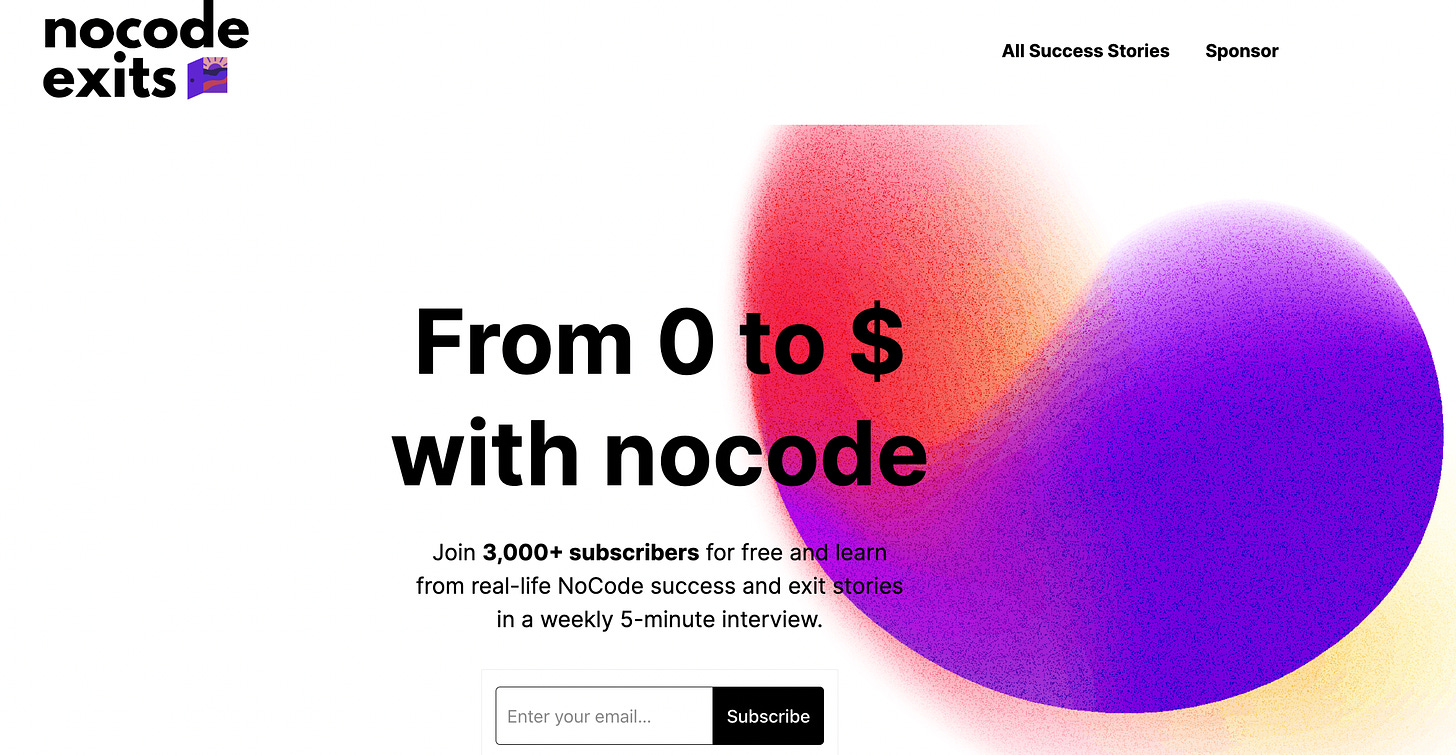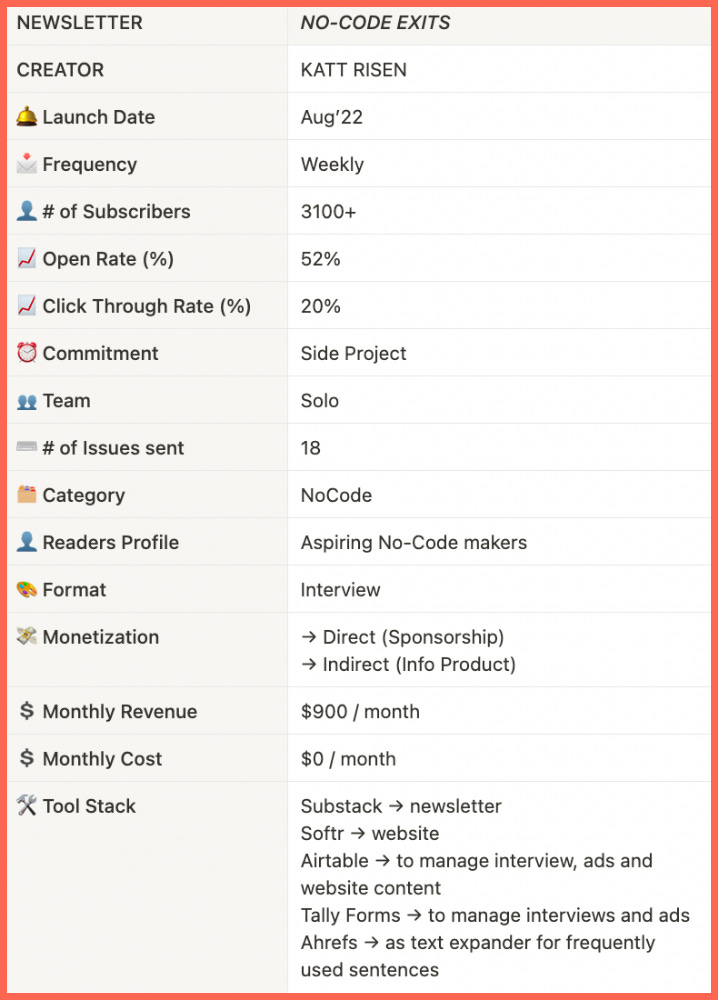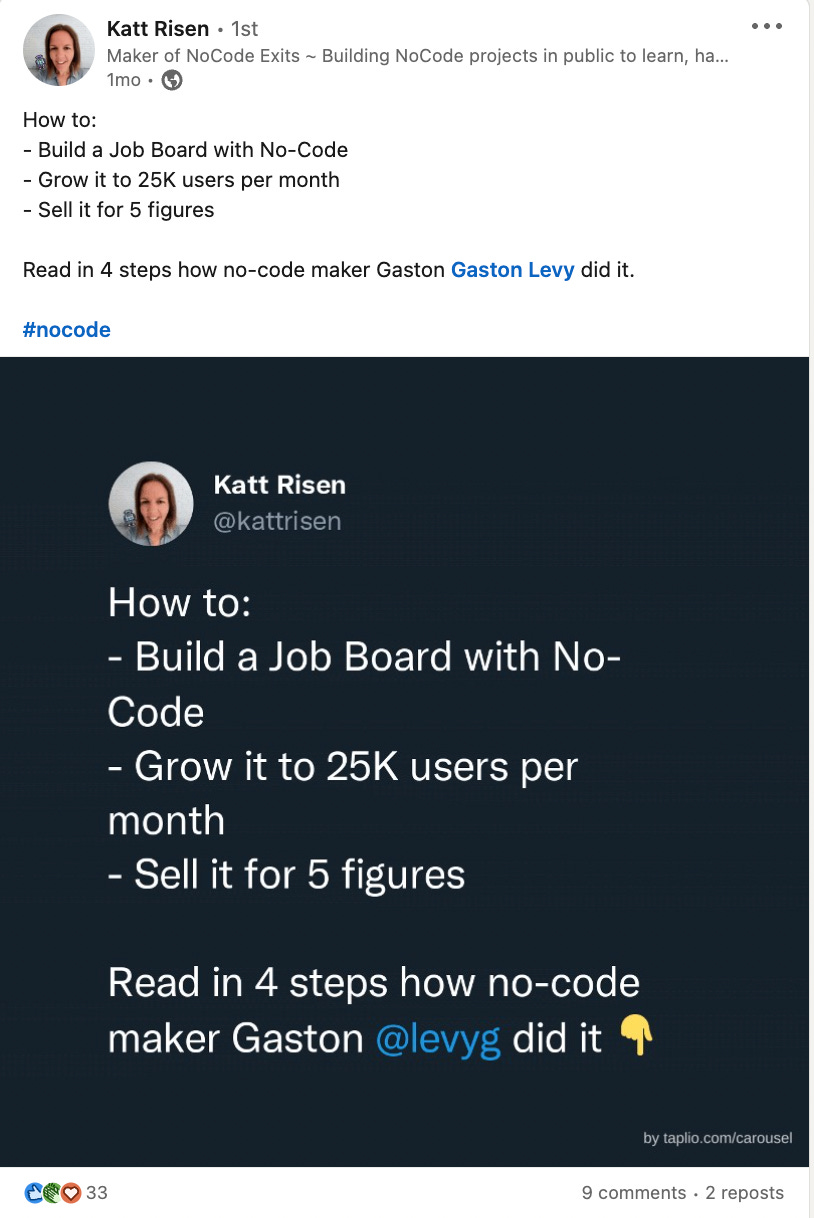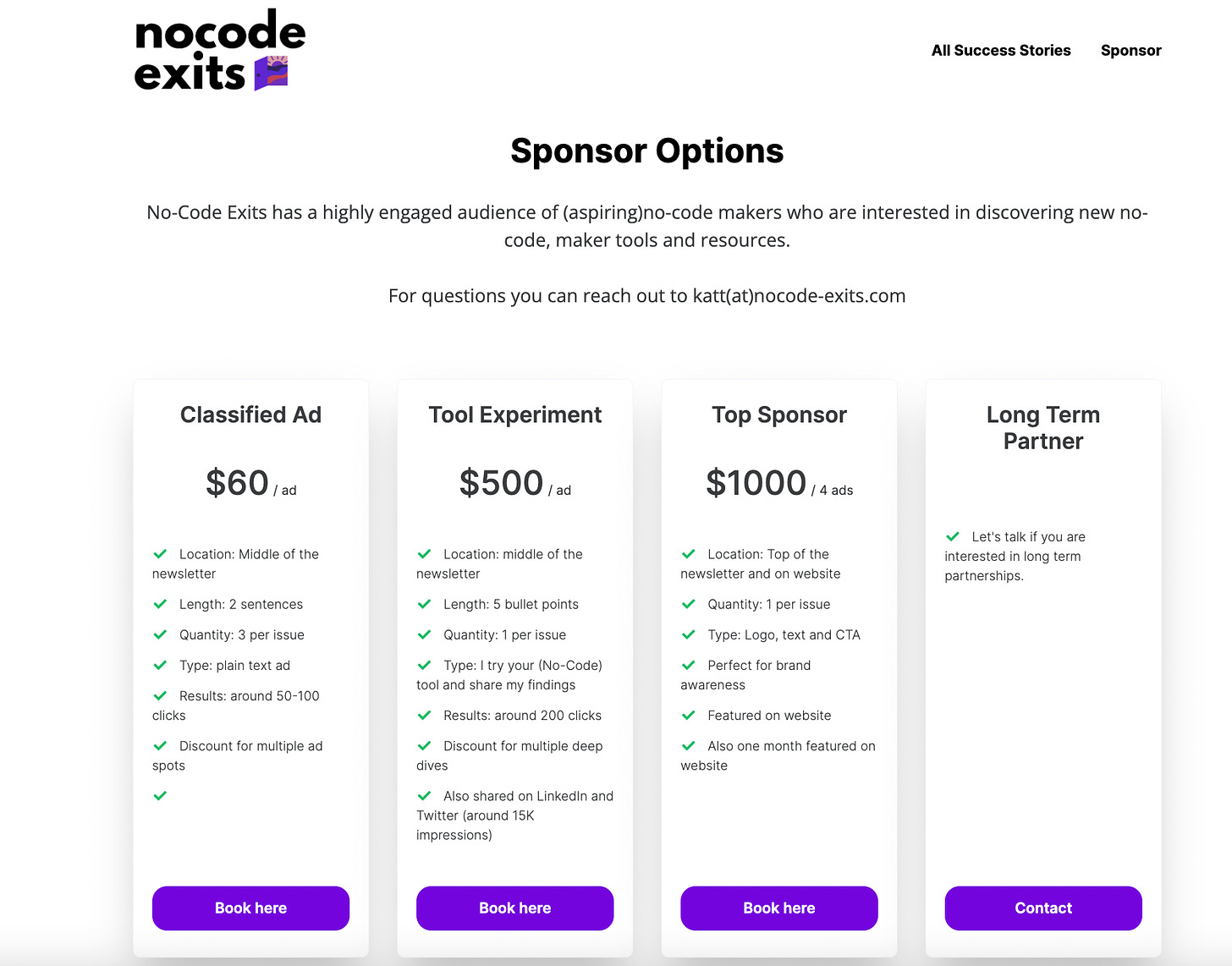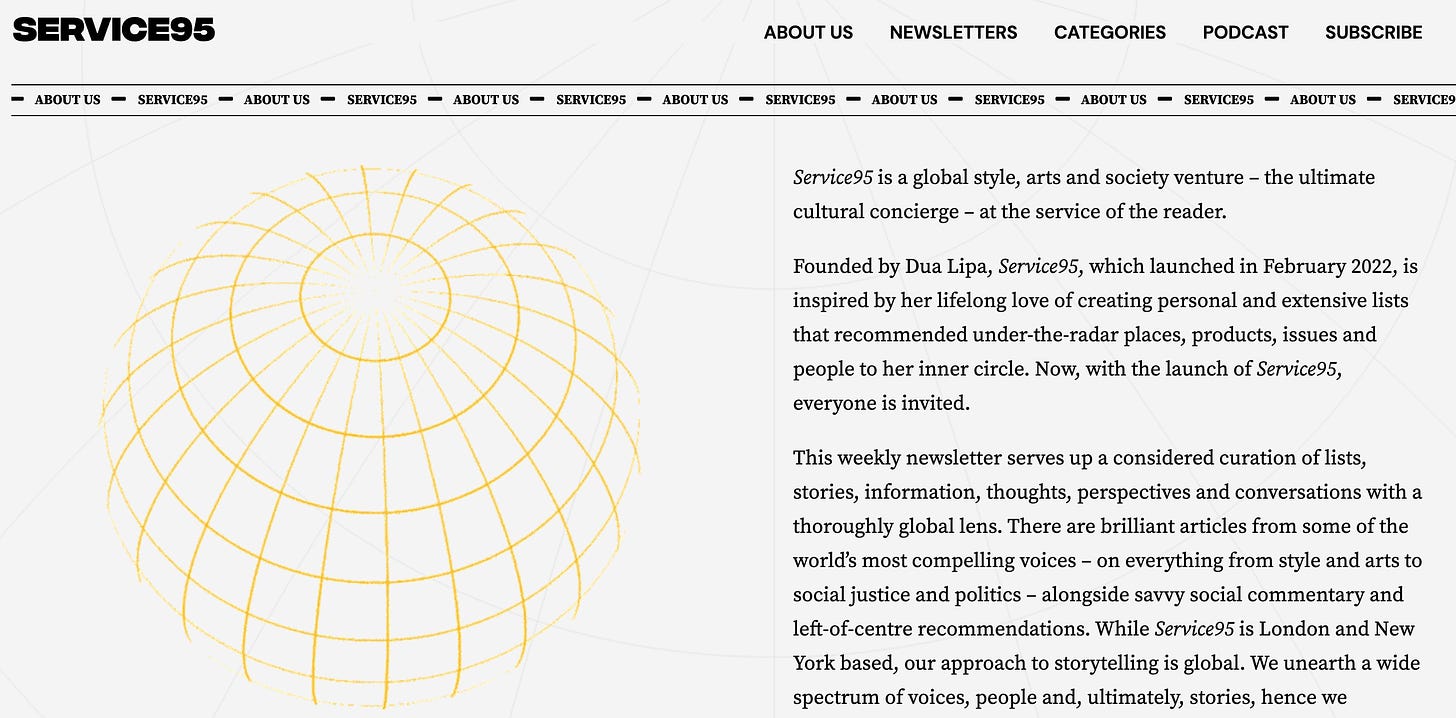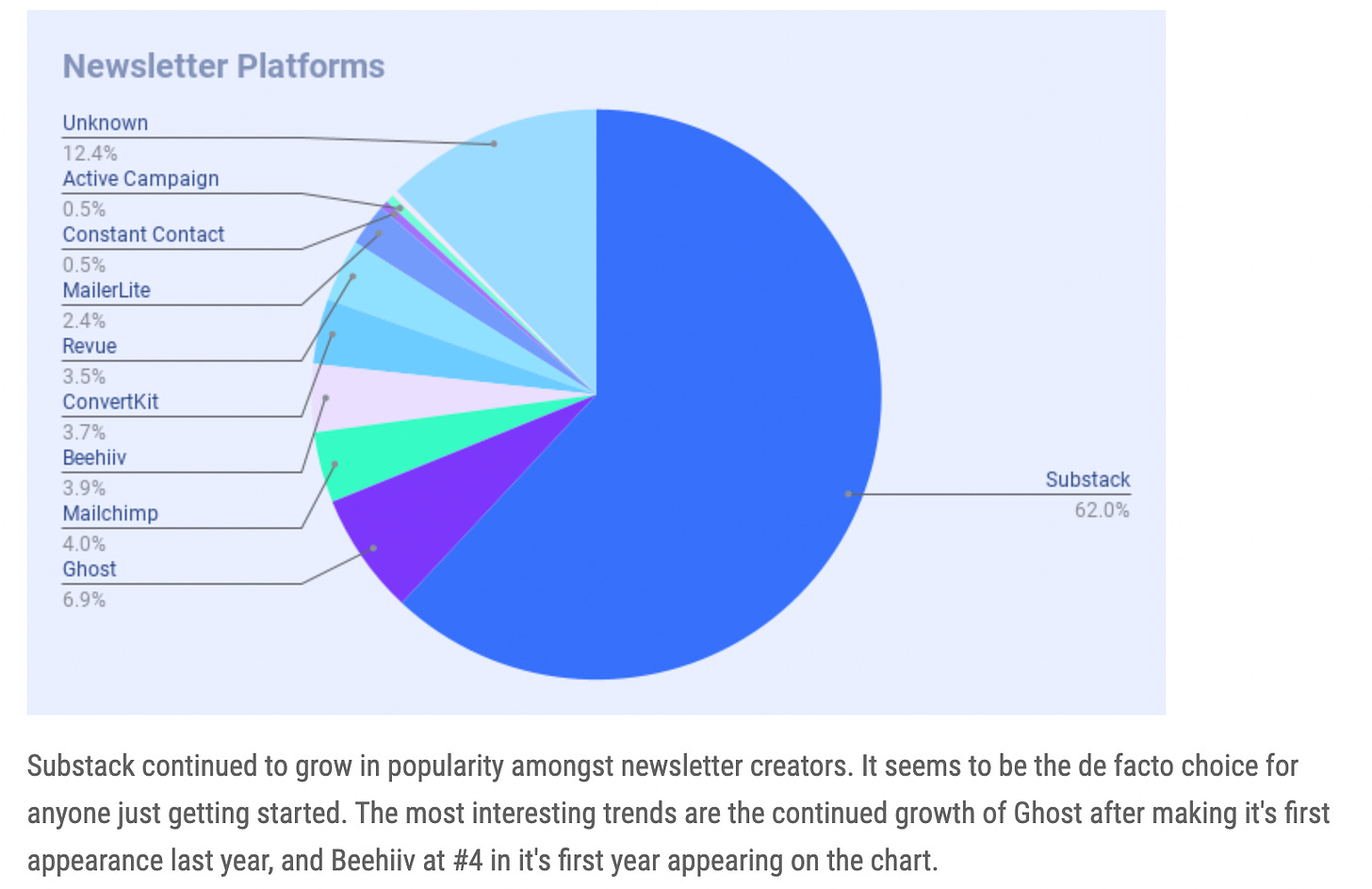⌨️ No-Code Exits by Katt Risen
3,100+ subscribers in 5 months; the power of "build-in public" in a tiny niche
Welcome to Newsletter Circle!👋
This is Ciler - the founder of Newsletter Circle, the newsletter all about newsletters for solo creators.
Every Sunday, you will read the unique journey of a different newsletter creator and learn more about how to start and grow your own newsletter.
📜 Weekly Z-Report by Ciler
The first week of Newsletter Circle was quite busy and I’m happy with all the small steps that make up progress at the end.
→ Important learning 1: Don’t underestimate the power of Reddit to share your newsletter. It may not bring hundreds of people at the beginning but you will gain subscribers who are sincerely interested in your creation, which is more critical.
→ Important learning 2: Keep your welcome e-mail short and crisp. Since the day I stopped overwhelming readers with many questions, I started to receive replies. I only have one request for now: “Let’s get connected on social media.” so that we can know each other better.
🎙CREATOR INTERVIEW
Today’s guest is Katt Risen, the creator of No-Code Exits, where she interviews successful No-Code makers since Aug’22.
I’ve been following Katt’s newsletter almost since the beginning and I’m amazed by its rapid growth and the way she builds a community around the no-code niche with a build-in-public approach. Today she has 3,100+ subscribers and generates a $900 monthly income. Let’s learn how she managed this.
🏷 NEWSLETTER IDENTITY CARD
Hello Katt. Let’s start with getting to know you.
I’m Katrien aka Katt. I live in Belgium and I recently quit my job to become a solopreneur. I’m now doing some freelancing and, in the meantime, building and launching different ideas to build a portfolio of tiny internet projects that, hopefully, one day, will make enough money to replace my income from freelancing. One of those projects is my newsletter: NoCode Exits.
How and why did you decide to start the No-Code Exits newsletter?
I have always had a fascination with technology and start-ups. I read every classic business book, listened to every IndieHacker podcast episode, checked Product Hunt every day, and lurked on forums and Twitter. I always had a lot of ideas (very annoying ;), but never the (coding) skills to build them.
Then very short:
I discovered No-Code
Joined 100 Days No-Code Bootcamp
That project got acquired
The tweet did very well when I tweeted about this acquisition and got loads of questions and DMs. I felt a very clear ‘pull’ that people were interested in these stories, so I decided on a whim to go for it and start a newsletter about it.
I decided to keep it very simple (also because I was leaving on holiday) and in less than 30 minutes, I had a Substack set up, a logo from a stock site, and a short description.
I wanted to validate the interest, so I announced it in a tweet. This resulted in around 200 subscribers. I had around 600 followers then. Validation: check.
The next day I published my personal story in the first issue. Then I left on holiday for two weeks, and after my holiday, I had around 700 subscribers.
Since capturing the first 100 subscribers is even difficult for many creators, how did you start with 200 subscribers immediately?
Those first subscribers were only from the tweet where I announced the newsletter. My Twitter followers were mainly people that were also learning and building with No-Code, just like me.
So, I think they just were so excited that my project got acquired, which resulted in many likes and comments on the tweet. I also think the very specific niche and intriguing subject helped a lot.

No-Code Exits reached 3,100+ subscribers in 5 months, which is a huge success.
Which growth strategies have you utilized and continue to use? What is the most impactful growth strategy in your case?
In the beginning (until 500 subscribers) it was only from tweeting about it and word of mouth.
After that, I also started to share it in some communities I’m part of and post the interviews on IndieHackers and Reddit. That was not very successful (max 10 new subscribers for every post), but I keep doing it as it’s not a lot of effort and who knows…
What really helped was that I tagged the tools, acquisition platform and maker after every interview and that also got retweeted often.
After around 1,000 subscribers, I started doing cross-promotions.
But the most effective strategy for me is growing my Twitter account (I had around 600 subs when I started my newsletter and now 4500) by tweeting a lot about NoCode.
I do this by building in public and repurposing the content of interviews in my tweets.
Examples are a summary of the interview, a fantastic quote or relatable anecdote, a summary with the tools and some tweets with learnings from different interviews.
This attracts people that are interested in NoCode and are, most of the time, also interested in my newsletter.
Could you take us through your monetization journey from the beginning?
I started doing sponsorships with around 1000 subscribers and found the sponsors by tweeting about it. Classified ad for 50 dollars, payment was made via Gumroad and I had three types (1 ad / 3 ads / 5 ads).
The multiple ads got a discount, which really helped in upselling to my first advertisers.


I have been experimenting with some other ad formats that resulted in better clicks for the advertiser. Which then again resulted in happy advertisers that buy more ads. But to be honest, it is still trial and error for me and takes a lot of time.
So I’m hoping to try out other monetization strategies this year or find some long-term partnerships. At this moment, I make around 900 USD per month.
In the last issues, I also have been adding affiliate links and Buy me a Coffee link so let’s see how that will perform.
I also share a small info product that I made (good-problems.co) in the footer of my newsletter. Most of the sales are thanks to the newsletter (now at 1000 USD).
Why did you choose Substack? Pros and cons?
I wanted to keep it simple and launch fast; for that, it was perfect. The simple editor is amazing.
But I dislike how closed it is and how limited the analytics are. You can only use the Substack embed form, no connection with Zapier is possible, so it is kind of hard to automate things or make a custom website. For that reason, I will probably switch.
Beehiiv seems interesting as they have an API, better analytics and a referral system but it’s not free. I will try it out and see if it’s worth the price.
But I think for getting started with a newsletter Substack is perfect.
What is your typical weekly process from creating to distributing a new issue?
Do async (via a form) or live (Zoom) interview
If via Zoom I use Descript app to get it from voice to text
Write the interview in Substack
Post teaser on Twitter
Ask small follow-up questions through email or chat
Add sponsorships and my weekly update
Publish
Repurpose the content of the interview and schedule it for the coming weeks
What are the pros & cons of running a newsletter in “an async interview format”?
→ Pro: It’s easier to convince people if it’s async. It’s much easier to convert it to a good newsletter, whereas video interviews take so much more time.
→ Con: You have to remind people to fill in the questions. You don’t form a personal connection with the interviewee compared to a Zoom interview.
How do you generate feedback and engage with your readers?
I did one audience survey with a Tally form which was very interesting.
Other than that, I’m very accessible by email and via Twitter.
I build this newsletter in public so every doubt, challenge and win are shared on Twitter and I get amazing advice like that.
How did writing No-Code Exits contribute to your life?
I’m on parental leave for eight months. My goal was to launch eight projects in eight months + see if I could secure an income with freelance gigs. I could secure sufficient freelance gigs I launched four projects before I started with NoCode Exits. Because this idea got the most traction, I decided to double down on it.
The combination of the freelance gigs and two projects that make a little bit of money gave me the confidence to quit my job 🥳
You also run a Dutch newsletter. Why did you start a second newsletter?
I started my Dutch newsletter to build an audience in my country to help me land freelance gigs. I never intended to create another newsletter, but I couldn’t resist when I felt this pull.
They are two different newsletters. The Dutch one is a curated newsletter (I’m still sending out issues but not actively promoting it) and then NoCode Exits is the long-form interview. I like both. Curating a newsletter helps you to keep up to date and follow all the news about your topic, and doing interviews is a great way to learn from others.
What is the most challenging part of writing a newsletter and how do you handle it?
When you are running a newsletter with interviews, you are dependent on others and need to make sure you find interesting stories, get input, send them reminders etc. I set up an Airtable base that really helps me to keep track of everything and everyone (interviews, ads, cross promotions etc.).
What is next on your newsletter journey? Short-term and long-term objectives?
My goal for NoCode Exits is that it becomes more than a newsletter.
My main objective is to grow the subscribers to 10K this year and turn the website into a platform that helps and inspires aspiring NoCode Makers.
What would it be if you had the right to give one piece of advice to aspiring newsletter creators?
Pick a tiny niche and think outside the box for your ads.
You manage many projects at the same time. Any productivity tips, maybe?
On Sunday, I make a weekly plan and assign 2-3 main tasks for each day.
My Twitter and LinkedIn are blocked from 10-12 AM and 2-4 PM, which I use for ‘deep work’. I try to focus on tasks that move the needle.
Which other newsletters would you like to recommend?
The Steal Club from Alex Llull
The Prompt from Anita
100 Days of NoCode Digest from Max Haining
Thank you so much Katt. Good luck with conquering the No-Code world!
🔗 Where to find Katt Risen and her work
Twitter, LinkedIn, No-code Exits, good-problems.com, Indie Kids, No-Code Guru (acq), Dutch Newsletter
📌 HANDPICKED PIECES
→ Did you know that Dua Lipa also has a newsletter, called Service95, with a corresponding podcast? And it is pretty good. Maybe I should interview her one day :)
→ The State of Newsletters 2022 report has been published by InboxReads. You need to have a look at it to learn key trends & insights in the newsletter space.
→ Learn which tools writers prefer in this tweet. The answers vary from Google docs to Obsidian.
Thanks for reading and don’t forget to leave your comments.
See you next Sunday!



